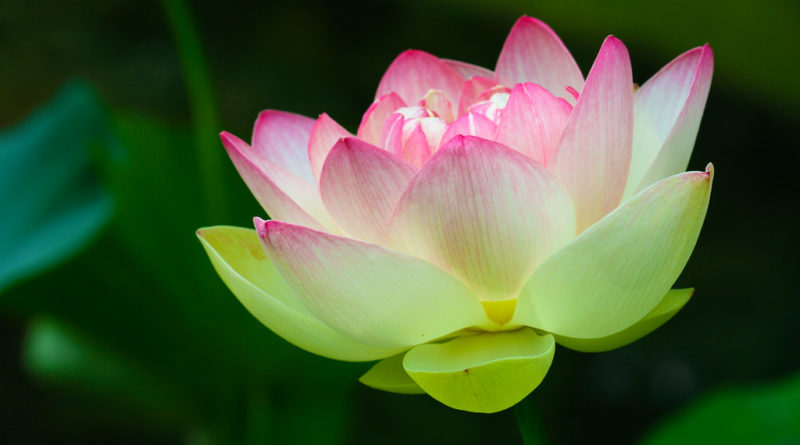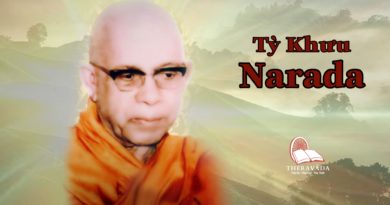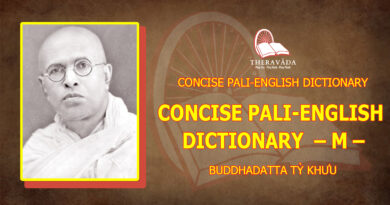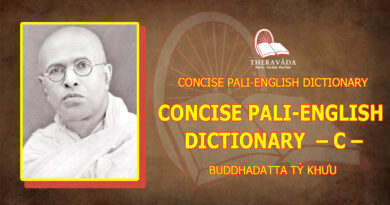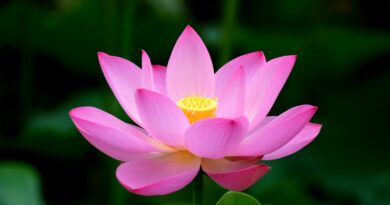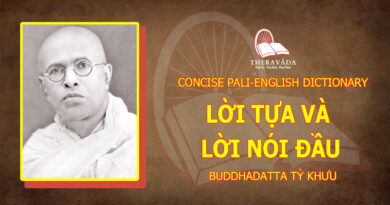THE LESSER, THE GREATER, THE DIAMOND AND THE WAY
THE LESSER, THE GREATER, THE DIAMOND AND THE WAY
A talk given on a retreat held The City of 10,000 Buddhas, Ukiah, California, July 1991
-oOo-
Historically there have been differences of opinion about the relative merits of Theravada and Mahayana Buddhism and, if you read much of the literature, they would seem to be quite divergent in their approaches toward Buddhist practice – yet there also seem to be some tremendous affinities.
When I arrived at the International Forest Monastery in Thailand, I had never read any Buddhist books and I wasn’t actually in search of becoming a Buddhist monk. I was a wanderer, a free-lance spiritual seeker, and I just happened to turn up at this forest monastery that Ajahn Sumedho had established a couple of years before, basically as a place for a free meal and a roof over my head for a few nights. Little did I expect, some twelve or thirteen years later, that I would be doing what I am doing now. But when I went there and asked the monks about Buddhism, to explain things a little bit for me so that I could get a feel for what their life was about, the first thing one of them did was to give me a copy of a book of talks by a Zen Master, and he said, “Don’t bother trying to read the Theravada literature; it’s terribly boring, very dry. Read this, it is pretty much the same thing that we’re doing, and it will give you a sense of what our practice is about. And I thought, “Well, obviously these guys are not too hung up on their tradition.” The book was ‘Zen Mind, Beginner’s Mind.’
So, one could see right from the beginning that, even though there is a strength to the particular form within any Buddhist country, one is not necessarily constricted or limited by that. I was there for months before I even heard of ‘Theravada’ and ‘Mahayana’, let alone the differences of opinion between them. It seemed that when you actually lived the life there really wasn’t any great disparity, but if you thought about it a lot, and if you were the kind of person who wrote histories and books and had got into the political side of religious life, then that was where the divergences occurred.
I have heard Ajahn Sumedho recount a few times over the years that, for the first year of his monastic life, he had been practising using the instructions from a Ch’an meditation retreat given by the Ven. Master Hsu Yun, and that he had used the Dharma talks from that retreat given in China as his basic meditation instruction. When he went to Wat Pah Pong, Ajahn Chah asked him what kind of meditation he had been doing, at first he thought, “Oh no, he’s going to get me to give this up and do his … method.” But, when Ajahn Sumedho described what he had been doing and mentioned that it had had excellent results, Ajahn Chah said, “Oh, very good, just carry on doing that.”
So, one sees that there is a very strong unity of purpose; even though there might be historical differences between the two traditions, they are very much in accordance with each other. And one begins to see what the different Buddhist traditions are talking about. They get sectioned out into Hinayana or Mahayana or Vajrayana, as different types of Buddhist practice, but they are basically just different labels which are talking about attitudes of mind and, when the traditions are used wisely, then they will address all aspects of our mind, from the most selfish and mundane to the most exalted. They address all the different levels of our life, and it’s only when they are not understood, when people take them as fixed positions, that there is any conflict amongst them.
Theravada Buddhism, for instance, is often taken to represent the Hinayana position, the self-concern of “Quick let me out of here, I’ve had enough of this mess; I want this to be over as quickly as possible.” One can see that that represents a very definite stage in one’s own spiritual development. For example, we start out with just a worldly attitude; basically we’re not interested in spiritual development at all. We just want happiness, however and wherever we can find it. We have a worldly outlook and no real spiritual direction at all. So then our first kind of awakening to spiritual life is when we start to acknowledge suffering. We recognize the need to rescue ourselves, to help ourselves.
So, the Hinayana refers to this initial stepping onto the spiritual path and seeing that there’s something that needs to be done to sort out our own life. It’s a natural self-concern; you don’t set about helping other people or being too concerned about the welfare of others if you yourself are drowning. You have to get yourself to some firm shore to begin with. But then basing your spiritual practice around self-concern, and just trying to make your own life peaceful and happy is obviously of limited worth. We can see that if we do get stuck at that level, there is a certain aridity and barrenness that will set in.
I had an interesting experience concerning this recently. Normally my personality is of a friendly, generous, outgoing type, and I’ve always had quite a fondness for the Mahayana Buddhist teachings. However, I found toward the end of last year that a certain nihilism was creeping in. The abiding tendency was one of “I’ve had enough of this; I want out.” This was really quite unusual for me and it started to come on very … strongly. The idea of living into old age and having to cope with human existence and the trivialities of life and the tedium of a boring monastic routine was … NO FUN. It all started to look incredibly uninviting. It was like being stuck out in the middle of a salt flat with no horizon visible. It was a strong, grinding negativity. I didn’t feel friendly toward anyone, I felt no inspiration toward monastic life. The whole thing was a tedious rigmarole.
Every two weeks we have a recitation of our monastic rules and it takes about 45 minutes to chant. This is the regular refreshment of the spirit of monastic community – renewing our aspiration and our dedication to our discipline and our life-style. And I’m sitting there reciting these rules and my mind is saying, “What a total farce, what a waste of time this is” – and … trying to remember the words I’m supposed to be chanting at the same time. Also, this was at the beginning of the monastic winter retreat that I was supposed to be helping to teach; I thought, “This is really … going to be difficult.” I was supposed to be inspiring these young monks and nuns and my mind was going through this very negative state. I was watching this, but there seemed to be a lot of justification for thinking in this negative way. I thought, “Well, maybe I had it wrong all these years, maybe I was just being an empty-headed, overly optimistic fool and maybe being a bored cynic was actually the right path all along.”
Then one night I had a very vivid dream, in full colour. In this dream I ate my hands, finger by finger. I pulled off my thumb and then each finger and ate them. It was so vivid I could taste them and it was even a bland taste. I ate the whole of my left hand then started on my right hand, and I ate the first three fingers until there was only my index finger and thumb left. Then something in me said, “Wake up!” I woke up and there was a very, very clear memory of this dream. Instantly I realized what I had been doing. Out of heedlessness I had been destroying those very faculties that were my most helpful friends and assistants. The negative and self-destructive attitudes were covering up and burning away all of the good qualities. The spiritual qualities that were there were being destroyed. It was really a shock to the system, and I realized I had been taking the wrong track. Then something else happened spontaneously. I had not really been thinking about Mahayana Buddhism or the Bodhisattva ideal, but what happened was that I started to say to myself, “Well, I don’t care whether I feel even one moment of happiness for myself in this life; I don’t care if I have to be reborn ten thousand million times. If I can just do one kind act for one other being in a thousand million lifetimes, then all that time will not have been wasted.” Thoughts like this began to come up spontaneously in my mind, and I suddenly felt an incredible joy and happiness, and a feeling of relief; which is strange if you think about it rationally: ten thousand million lifetimes of ineffective activity and complete pain and boredom. But the result was a vibrant joy and delight. It was the breaking out of the prison of self-concern.
When the mind goes into that kind of death-wish mentality, just waiting for it all to be over, then all you’re concerned about is yourself. You become blind and immune to other people. Even if you don’t want to be, you find that you’re building all sorts of walls around yourself. And I could see that this was very much the cause of the spirit of the Mahayana tradition and teaching: to arouse that unselfishness, that readiness, even if it is a pointlessly vast task, to take it on anyway. It then releases the natural altruism and affinities we have for other beings. We recognize our interconnectedness with all other beings, all other lives, and out of respect for that, one feels a sense of joy in being able to give, to help and to serve.
It is interesting that, at about that same time, someone gave me a book which showed me that this principle was found not only in the Buddhist tradition. The author was talking about this principle and gave examples from both the Hindu and the Judaic traditions. He told the story of Sri Ramakrishna and how, before he and Swami Vivekananda were born, he had tracked down Vivekananda (who was his chief disciple) up in one of the high Brahma heavens – he was absorbed in meditation, utterly disinterested in the world, “Close to the mountain of the Absolute.” What a great phrase! Anyway, Vivekananda was seated there, totally enraptured in bliss. Then Ramakrishna took on the form of a little child; he wove the body of a golden child out of the atmosphere of this high realm and he started to sing and play in front of this sage. Eventually, after some time, the sage’s attention gets caught and he opens his eyes and sees this incredibly charming little child, playing and cavorting in front of him. And finally, with his eyes completely opened, he is looking at the child, and the child says to him, “I’m going down; you come with me.” So, Vivekananda went down and joined him.
The other example was of a Rabbi named Rabbi Leib. He was telling some of his disciples, “Before this life I did not want to be born; I did not want to come here. This human world is so full of foolishness and crazy, idiotic people. I had had enough of the whole thing and just couldn’t be bothered with it. And then one day this fellow comes along, he looked like a peasant, with a shovel over his shoulder, and he says to me, ‘Haven’t you got anything better to do than to lie around here all day just enjoying the bliss of eternity. I work non-stop just trying to bring a little happiness, a little more joy, into the lives of other people, and what are you doing? You’re just hanging around!'” He said that he was so touched by this person that he agreed to go along. This fellow with the shovel was the Baal Shem Tov, one of the founders of the Hassidim. It is said that he roams around the upper realms of the cosmos looking for likely characters whom he can dispatch down to earth to take care of the likes of us. So, it is interesting to see that this same principle exists in human experience in different traditions.
Self-concern takes us into a desert experience – even when we notice that the more coarse defilements of mind have abated or have worn themselves out, when we’re not possessed by too much anxiety or lust, greed, aversion, jealousy, or whatever, and the mind is quite peaceful. As you may be aware, now that you’ve been a week into the meditation retreat, you can be sitting there with your mind quite concentrated, quite still and, rather than feeling rapture or a sense of wholeness and totality, the feeling is one of, “So what? Is this really what the Buddha built his teaching around, this blank mental state, with nothing much happening?” With nothing much in the way of thoughts and feelings, no great passions to wrestle with, it’s like being in some little grey room. It’s not disturbing in any way, but it seems a pretty tame experience to build a world religion around.
You think, “This is a rip-off! I’ve been struggling away for five or six years with fear and lust and so on, and now I get to the free space – here we are out in the open – and it’s a desert. This is not … right!” But then, what you realize is that this is not what the Buddha was pointing to as the goal of the holy life, because even though one can’t see any outstanding objects causing obstruction or defilement, what is there is you … , or in this case, me … . There is the sense of I … – someone here experiencing – there’s a person. This sense of identity, even though it is not outstanding, leaping out making itself vivid, is a constant presence. The ego is a psychological structure that is there like a wall around us, like a prison. And because we are so caught up with life in the prison, we don’t notice that we are actually hemmed in. It is only when everything has cooled down and one has a chance to look around and take in the surroundings that one has a chance to feel the sense of limitation, barrenness; there’s a boredom, it’s just BLEAAGGHH!
Even in Mahayana Buddhism – which is outgoing, geared toward altruism, generosity, compassion, developing a spiritual life for the sake of all beings – if our practice stops at the state of,’ Me giving my life to help all others’, even if this is highly developed, at the end of it there’s still ME and YOU – me who is helping all sentient beings. Even in that respect, even though there can be a lot of joy, you still find this barrier, a sense of isolation or meaninglessness. There’s a separation there. So, it is important to use the meditation practice to not just absorb into altruistic thoughts and feelings, because, if you notice, a lot of the Buddha’s teachings revolve around selflessness, around emptiness, like the teachings on Anatta … . If there is no self who is it who’s going to be radiating kindness over the entire world? If there’s no self, then who is sending Metta … and who is there to send it to?
One then sees that there is a level of understanding, of being, which is beyond that which is tied up with self and other. No matter how high, refined and pure our aspiration might be, unless we go beyond that sense of self-identity and division in that respect, then there will always be that feeling of incompleteness; the desert experience will creep in.
So, if we pass through that grand-hearted attitude of mind, then we realize that which pertains to the wisdom of ultimate understanding, of Ultimate Reality; that which is called the Vajra teachings. Vajra … means diamond or thunderbolt, indestructible, supremely powerful, the adamantine Truth. This is the understanding of selflessness. When the attention is put onto the feeling of “I”, one uses the practice to illuminate the assumptions we make about our identity. We have to turn the mind around from external objects, to shine it back upon the assumptions that we make about the’subject’. When the mind is calm and settled, it’s very helpful to start inquiring, “Who is the person that is the centre of all of this?” “Who is it that is meditating?” “Who is it that’s knowing this?” “Who is the one who knows?” “What knows thought and feeling?” It’s when we look and challenge the assumptions about there being a discreet entity here, then suddenly the prison walls collapse.
I had an experience of this some six or seven years ago – when I first started using this kind of meditation on a long retreat, asking “Who am I?”, or “What am I?” and using that to create a hesitation in the mind, to put the sense of self into perspective; it felt like stepping out of a grey prison cell into sunshine and a field of flowers. It was a tremendous feeling of refreshment and relief, like coming across an oasis in the desert.
The Buddha said that the greatest happiness of all is to be free from the sense of “I am.” Now, this might seem to some people to be a bit farcical or pointless, because our ‘self’ seems to be the most real thing in the whole universe – “If anything is real, I … am.” But it’s only because we have never really looked, or inquired into the feeling of I … , of me … , of mine … . It’s only because we have never really studied that and seen it clearly that that illusion is maintained. Once you look at it closely, then the illusion falls apart. You can’t be taken in by that.
So, one uses enquiry to challenge the assumptions that we are making and the walls that we create within the mind. That challenging of those assumptions is what dissolves the illusion. The instinct of the ego, however, is to immediately start creating things which produce activity elsewhere so that our attention will be distracted, so that we will stop doing this. The ego is like any creature that is frightened of dying, and as soon as we start to challenge the supremacy and the centrality of it, then a panic reaction gets going. You will find that the mind can throw up all kinds of interesting and compelling thoughts to persuade you to engage in something else quickly … . So, one requires a great deal of resolution just to say ” NO … !” and to bring the mind back to asking, “Who is this?” “What is knowing this panic?” “What is knowing this feeling?”
In the Vajra Praj~naa Paaramitaa Sutra … you find statements like “No mark of self, no mark of other, no mark of living beings, no mark of a life,” or “All conditioned dharmas are dreams, illusions, bubbles, shadows, like dew drops and a lightning flash, contemplate them thus,” or “Everything is made from mind alone.” And in the Heart Sutra as well, which they recite here at the City of 10,000 Buddhas every day, there are sections of it which go, “There is no form, no feeling, no perception, no mental formations, no consciousness, no ignorance, no birth, no aging, no death, no suffering, no attainment and no Way.” What this is doing is stepping out of the whole conditioned realm, putting the whole conditioned realm into perspective – do not seek for liberation, for certainty, for security in that which is inherently insecure, inherently bound and tied up with time, self, birth and death. As long as we are seeking for happiness in the conditioned sensory world, then we are bound to be disappointed. We cannot possibly find it there. And things like birth, death, self, other, suffering – these are relative truths and ultimately there is no suffering, no one is ever born, no one ever dies. All there is is “Suchness” or “The Wonderful” or “Universal Mind” or any one of a number of terms that are used.
The interesting thing is you don’t find this just in the Mahayana or Vajrayana texts. It is fully explained and spelled out by the Buddha also in the Theravadin scriptures, although it may not get emphasized enough. You even get teachers who say that Anatta should not be taught, that it is a dangerous teaching. After a talk that Ajahn Sumedho gave once, a well-known Buddhist teacher who was there was incredibly upset and disturbed that Ajahn Sumedho was teaching Anatta to lay people. He thought this was most irresponsible (although he himself was a lay person!). Also I’ve been told of an eminent monk in Thailand who feels the same way; he thinks that Anatta is too potent a teaching to pass on to all of you … people, but I don’t think so ( laughter … ). This is the supremely liberating teaching, and you find a lot within the Theravada that is glossed over, that does continually push the mind to this point of ultimate wisdom.
For example, there is an inquiry made to a monk called Anuradha where he’s questioned by some Brahmin scholars on “What is the nature of an enlightened being after death?” “What happens to a Tathagata, an enlightened one, after the death of the body?” “Do they exist?”
The monk replies, “This is not spoken of by the Enlightened One.”
He is asked, “Well, do they not … exist?”
“This is not spoken of by the Enlightened One.”
“Well, do they both … exist and not … exist?”
“This is not spoken of by the Enlightened One either,” he replies.
“Then, do they neither … exist nor … not exist?”
“This, too,” he says, “is not spoken of by the Enlightened One.”
So they say to him, “You must be a fool or one who is newly gone forth. You obviously do not understand the Buddha’s teaching or you would be able to give us a decent answer.”
Then he goes to the Buddha and tells the Buddha of the conversation he had with these people, and he asks, “Did I answer in the right way?” And the Buddha said, “Yes, Anuradha you answered well.”
“Do you see the Tathagata as being … the five khandhas … ?”
“No Lord”.
“Do you see the Tathagata, as having … the five khandhas … ?”
And he says, “No, Lord.”
“Do you see the Tathagata as not … having the five khandhas … ?”
And he says, “No, that’s not true either.”
“Do you see the Tathagata as being within … the five khandhas … ?”
“No Lord.”
“Do you then see the Tathagata as being separated from … , outside of, the five khandhas … ?”
He says, “No, not that either.”
“Correct!” said the Buddha, “Just so – what I teach, both now and formerly, is suffering and the end of suffering.”
The Buddha advises us not to try to define the enlightened in conceptual terms because any conceptual definition can only fall short, can only be relatively true. The Buddha made very clear in the Theravada teaching just as much as in the scriptures of the Northern school that the ultimate perspective on things is the perspective of no fixed position, of actual realization … of Truth, abiding in that position of Awareness, rather than taking any kind of conceptual or idealistic position. That is our Refuge. Taking Refuge with Buddha is being that Awareness. So that we see that everything to do with our body, our feelings, our personality, our age, our nationality, our problems, our talents, all of these are simply attributes of the conditioned world that arise and pass away and there is awareness of those. The whole point of the practice is to constantly abide in that quality of Awareness.
Life is going to be frustrating and painful if we are looking for certainty and definition in terms of being a person, being some place – a being in time. It’s only when we let go of the sense of I … , me … and mine … , of the sense of there being a person here who has anywhere to go to, or anywhere not to go to, that there is the clear abiding in Awareness.
The tendency of the mind is often to conceptualize that. You say, “OK, I’m just going to be aware,” and you take that as an ideal and try to fill the mind with that thought. What will happen then is that the thought turns into an object, so rather than just resting in being … the knowing, we try to see what it is that is knowing. As Ajahn Chah would sometimes say – you’re riding a horse and looking for the horse. We wonder, “Who is it that knows the knower?” “Who is it that knows the thing that’s knowing the knowing?”
One can get the impression that there’s some sort of infinite regression happening here, and that it’s like falling off a cliff backwards. But it’s not – because what happens is that when we let go of our sense of identity, then there is just the clear knowing. The mind rests in the bright, selfless, knowing, timeless state. And then the idea arises, “Oh, there is knowing.” So rather than just resting in that pure knowing, we attach to the thought that there is something that is knowing. We’re just fixing on that thought and then stepping out into the conditioned world. As we attach to any thought we’re stepping away from that sense of pure knowing. If there is just pure knowing it’s like being up against the back wall. As soon as we hold onto any thought we walk away from the wall. We’re going out into experience, going out into attachment to some condition.
If we just allow the mind to relax and rest in that sense of knowing, in that purity of being, then there is liberation, there is freedom right at that point. At that point, the mind is aware of the sense of unity, of Suchness, there is the unifying vision which in Christian terms they call beatitude. The beatific vision is the vision of totality, of wholeness, the disappearance of any separateness. In this realisation there is no self – it’s not you being with Ultimate Truth – there’s just THIS … , the mind in its pure awakened state, Dhamma aware of its own nature.
With the early presence of Buddhism in America in the 1950s and early 60s, there was a tremendous amount of use of this kind of understanding; people were saying, “Everyone is a Buddha,” “We’re all Buddhas,” “Everyone is perfect.” And, instead of this giving rise to people having the conduct of Buddhas, which is modest, gentle, and restrained, what this was sometimes taken as was a justification of license. Whatever you do, it’s perfect – sober is perfect, drunk is perfect, to do whatever you feel like doing, whatever you’re inspired to do – it’s all empty. It’s all Suchness. For people who took that highest principle as a fixed position or identity to hold onto … you can see that just the idea of it was not enough, and it caused some of the brightest Buddhist lights of the Beat generation to die as alcoholics. There was a great sense of freedom of spirit that was inspiring it, but the idea of us all being Buddhas and everything being perfect is not exactly the same as the direct realization … of that. When the mind truly rests with that realization, then what flows forth from it is a purity of conduct, a purity of speech and action, a gentleness, a harmlessness and simplicity. The Buddha’s response to his enlightenment, being totally free and beyond any suffering, was not to pursue physical pleasures or seek intoxication. His response was to live incredibly carefully and modestly, using the things of the earth with frugality. He could have conjured up anything he wanted, but he chose to live as a barefoot renunciant, a peaceful, harmless being.
One can see that some Buddhist traditions over the centuries have become caught up in this problem, whereby the principle is attached to and then taken as an identity – “I am a Mahayana Buddhist,” or “I am a Theravadan Buddhist,” or “I am a Vajrayana Buddhist.” That’s like wearing a badge that gives one a certain credential, rather than seeing that the terms referred to are attitudes of being. For instance in England, at the Buddhist Society summer school every year, one group would go and have their evening meetings down at the pub, ostensibly because they “had got beyond form.” So, they would have their evening Dharma discussions down at the pub, which is all right; they are free to do what they want. The Theravadans just sit around, chatter and drink tea. But you could see that the attitude was, “Well, we’re of the Supreme Vehicle. We don’t need to be bothered with the petty concerns of Sila; we respect the ultimate Buddha nature of all beings.” And one could see that a lot of their inspiration and noble energy was getting side-tracked into justifying the simple quality of preference: that they found it enjoyable to have a drink or two, fool around and have an unrestrained time. Again, they are free to do as they choose, but its a sad mistake to label this as the practice of Buddha-Dharma.
The result of this – trying to realize emptiness within a free-wheeling life – means that we then have the challenge of realizing the emptiness of the despair and depression that comes from following those desires. People are free to take on the challenge!!! But it’s a related thing; we can’t just absorb into pleasure without getting the other side of it as well. It’s as if we’re holding onto the wheel as it goes up the pleasure side, but we’re still holding onto it as it goes down the other side. I’m not saying these things as a put-down but, having done this quite a bit myself, I realize that we just don’t have the presence of mind to let go at the top! It’s the way we’d like it to be but it doesn’t operate like that.
At the beginning of the retreat everyone took the Refuges and Precepts. This symbolic act is to refresh our aspiration toward being a Buddhist, toward being Buddha. It’s not a ceremony that one goes through to … become a Buddhist, like a baptism. It’s much more that it’s up to us to refresh our aspiration within ourselves. Externally, we can adhere to a form, to a tradition, to a pattern but if we don’t eventually internalize that, if we don’t bring that within ourselves and make being Buddha, being The-One-Who-Knows the aim, then any amount of external dedication to a particular form or tradition will not avail us very much in the long run.
One final point that we tend to not understand is that:- if there is no self, if one is aiming to come from this position of ultimate wisdom, then why do we bother with things like spreading metta … . If there is nobody here and nobody there, then why go through all the trouble of sending metta … across the universe? Or the sharing of merit: you know there’s no one here … and there’s no one there … , so what’s the point? Wouldn’t we be better off saving our energy and doing something else? This is important to understand – how the different levels of our life interplay with each other – because even though at some moment we might be seeing life from the level of pure wisdom, from that place of timeless-spaceless-selfless awareness, the rest of the world is not necessarily seeing things from that point of view. What you have within Buddhist practice is a way of tying together all the different levels of our being.
The Buddha used conventional forms, he used personal pronouns. When people asked him questions such as, “If there’s no self, why do you refer to yourself as an individual? Why do you talk to other people, why do you name people?” And the Buddha said, “Even though fundamentally there is no self, I use common speech in order to communicate things to people on a level that they can understand.” So, when we are thinking about things like spreading metta … , creating good karma, sharing the blessings of our life, one puts forth the effort to do that. You put your heart into spreading loving-kindness. You do … it.
We set up monasteries, we put effort into creating opportunities and environments for people to learn from. We teach, offer guidance and support and instruction. But, having brought those forms into existence, then one dissolves any attachment to them. We bring forth wholesome principles and energies into people’s lives, but we do not give them a sense of ultimate substantiality. We see that they are merely shapes, forms, patterns of consciousness. The sounds that I say, these are ear-consciousness, sounds that you all are aware of. There is the expression that the Buddha was the supreme weaver of dreams in order to wake up the dreamers. His teachings, his words and actions, are a system of dreams. Dreamstuff. But the mastery of the Buddha was that he created dreams which enabled the dreamers to awaken; to lead us out of the dream world into real life, into the true world.
As an example, for many years I had no feeling at all for devotional practice. ” Anatta … , that’s what it’s all about!” Every morning and evening, as we did our traditional chanting I would go along with it, try to stay in tune and so on, but basically I felt it was all pointless. Then I began to realize that I was missing the spirit of the whole thing – if we have right understanding, then we can bring forth those energies into words, bring forth kindness and benevolence, bring forth things which are useful and helpful into the world – but then not to own them, to leave them as they are, that is the great art and it is also the greatest blessing. You can see why the Buddha taught in the way that he did. It wasn’t for him … . It was to provide things for those of us who would come after: forms, patterns, traditions, ways of living that help to spur us on; ways to encourage us, to inspire us to wake up, to break through the illusions that bind us so that all can experience the true joy of liberation.
Ajahn Amaro
Source: Budsas.org

